Performance and Economic Analysis of the Multi-Energy Complementary Heating System under Different Control Strategies in Cold Regions
Abstract
:1. Introduction
2. Description of Experimental System
2.1. Testing House Information and Climate Condition
2.2. Component of MECH System
2.3. Testing Instrument
2.4. Control Strategy
3. Evaluation Methodology
3.1. Energy Analysis
3.2. Operation Cost Analysis
4. Results and Discussion
4.1. Analysis of RS-CON Test Results
4.2. Analysis of HST-CON Test Results
4.3. Comparison of Different Control Strategies
4.3.1. System Performance Analysis
4.3.2. Analysis of Economic and Environmental Benefits
4.4. Application and Analysis of the HST-CON at the End of the Heating Period
4.5. Application Analysis of HST-CON over Entire Heating Season
5. Conclusions
- (1)
- In the middle of heating, compared with RS-CON, HST-CON with sufficient SE can afford a higher solar fraction by 10%, more HST heating hours, and a lower operating cost and CO2 emissions. In addition, compared with the energy-saving advantages and heating efficiency of other heating system control strategies, HST-CON had certain feasibility in rural building heating. In addition, during heating operation, Mode 3 was the best heating mode.
- (2)
- At the end of the heating period, under HST-CON, the average indoor temperature was kept at 292.55 K by using Mode 5, and the average power consumption was only 0.22 kWh for an average of 5.99 h of heating, which indicated that the control strategy can meet the indoor heat demand and had a significant energy-saving effect.
- (3)
- In the entire heating season, Mode 3 in the middle of the heating period and Mode 5 at the beginning and end of heating period provided a total heating supply of 30.81 GJ, in which 19.21 GJ and 11.60 GJ were from the SE and BE, respectively, which constituted 62.35% and 37.65% of the total system’s heat supply, respectively. Under the same heating conditions, the payback period of the system was 9.73 years. Compared with traditional coal-fired heating, electric heating and air source heat pump heating, the system had the lowest annual energy consumption cost and achieved almost zero CO2 emission.
Supplementary Materials
Author Contributions
Funding
Data Availability Statement
Acknowledgments
Conflicts of Interest
Nomenclature
| Qco | Instantaneous heat output by collector: W |
| Troom | Least favorable room temperature, K |
| Taverage | Average temperature of HST, K |
| Ttop | Upper temperature of HST, K |
| Tmiddle | Middle temperature of HST, K |
| Tlower | Lower temperature of HST, K |
| TBB,supply | BB water supply temperature, K |
| TBB,return | BB return water temperature, K |
| Ta | Ambient temperature, K |
| I | Solar radiation, W/m2 |
| Qvtc | Heat accumulated by VTC, W |
| Cp | Specific heat capacity of working fluid, J/(kg·K) |
| mvtc | Mass flow rate of fluid circulating in VTC, kg/s |
| Tvtc,out | Outlet fluid temperature of VTC, K |
| Tvtc,in | Inlet fluid temperature of VTC, K |
| Qst | Heat supplied by HST, W |
| Cpt | Specific heat capacity of water, J/(kg·K) |
| mst | Mass flow rate of fluid circulating in HST, kg/s |
| Tst,out | Outlet fluid temperature of HST, K |
| Tst,in | Inlet fluid temperature of HST, K |
| Qb | Heat supplied by BB, kW |
| mb | Mass flow rate of fluid circulating in BB, kg/s |
| Tb,out | Outlet fluid temperature of BB, K |
| Tb,in | Inlet fluid temperature of BB, K |
| Qeth | Heat supplied by ETH, W |
| meth | Mass flow rate of fluid circulating in ETH, kg/s |
| Teth,out | Outlet fluid temperature of ETH, K |
| Teth,in | Inlet fluid temperature of ETH, K |
| f | Solar fraction |
| C | Cost incurred by MECH system operation, RMB/USD |
| Pe | Electricity price, RMB/kWh (USD/kWh) |
| E | Electricity consumption, RMB/USD |
| Pb | Price of biomass fuel, RMB/kg (USD/kg) |
| Mb | Biomass fuel usage, kg |
| Abbreviations | |
| MECH | Multi-energy complementary heating |
| SE | Solar energy |
| BE | Biomass energy |
| RS-CON | Room temperature control strategy |
| HST-CON | The heat storage tank control strategy |
| HST | Heat storage tank |
| VTC | Vacuum tube collector |
| BB | Biomass boiler |
| ETH | Electric tube heater |
References
- Zhang, Y.; Xia, J.; Fang, H.; Zuo, H.; Jiang, Y. Roadmap towards clean heating in 2035: Case study of inner Mongolia, China. Energy 2019, 189, 116152. [Google Scholar] [CrossRef]
- Shahzad, U.; Gupta, M.; Sharma, G.D.; Rao, A.; Chopra, R. Resolving energy poverty for social change: Research directions and agenda. Technol. Forecast. Soc. Chang. 2022, 181, 121777. [Google Scholar] [CrossRef]
- Guo, M.; Cai, S. Impact of Green Innovation Efficiency on Carbon Peak: Carbon Neutralization under Environmental Governance Constraints. Int. J. Environ. Res. Public Health 2022, 19, 10245. [Google Scholar] [CrossRef] [PubMed]
- Building Energy Research Center of Tsinghua University. Annual Development Research Report on Building Energy Efficiency in China 2020; China Construction Industry Press: Beijing, China, 2020. [Google Scholar]
- Dong, Z.; Bingyang, L.; Qintong, Z.; Jinping, L. Thermal performance and energy characteristic analysis of multiple renewable energy complementary heat pump system. Sol. Energy 2020, 196, 287–294. [Google Scholar] [CrossRef]
- Ge, T.S.; Wang, R.Z.; Xu, Z.Y.; Pan, Q.W.; Du, S.; Chen, X.M.; Ma, T.; Wu, X.N.; Sun, X.L.; Chen, J.F. Solar heating and cooling: Present and future development. Renew. Energy 2018, 126, 1126–1140. [Google Scholar] [CrossRef]
- Hou, Y.-T.; Yang, B.; Zhang, S.-Y.; Qi, Y.; Yu, X.-H. 4E analysis of an integrated solar-biomass heating system: A case study in rural housing of northern China. Sustain. Energy Technol. Assess. 2022, 53, 102794. [Google Scholar] [CrossRef]
- Verhagen, T.J.; van der Voet, E.; Sprecher, B. Alternatives for natural-gas-based heating systems: A quantitative GIS-based analysis of climate impacts and financial feasibility. J. Ind. Ecol. 2021, 25, 219–232. [Google Scholar] [CrossRef]
- Mi, P.; Ma, L.; Zhang, J. Integrated optimization study of hot water supply system with multi-heat-source for the public bath based on PVT heat pump and water source heat pump. Appl. Therm. Eng. 2020, 176, 115146. [Google Scholar] [CrossRef]
- Guo, F.; Li, Y.; Xu, Z.; Qin, J.; Long, L. Multi-objective optimization of multi-energy heating systems based on solar, natural gas, and air- energy. Sustain. Energy Technol. Assess. 2021, 47, 101394. [Google Scholar] [CrossRef]
- Zhang, X.; Yang, J.; Fan, Y.; Zhao, X.; Yan, R.; Zhao, J.; Myers, S. Experimental and analytic study of a hybrid solar/biomass rural heating system. Energy 2020, 190, 116392. [Google Scholar] [CrossRef]
- Liu, Z.; Liu, Y.; Wu, D.; Jin, G.; Yu, H.; Ma, W. Performance and feasibility study of solar-air source pump systems for low-energy residential buildings in Alpine regions. J. Clean. Prod. 2020, 256, 120735. [Google Scholar] [CrossRef]
- Zhang, X.; Wang, E.; Liu, L.; Qi, C.; Zhen, J.; Meng, Y. Analysis of the operation performance of a hybrid solar ground-source heat pump system. Energy Build. 2022, 268, 112218. [Google Scholar] [CrossRef]
- Gao, W.; Wang, Y.; Yang, L.; Xu, S.; Zhou, W.; Guo, H. Performance evaluation for solar combined gas heating system. Renew. Energy 2021, 167, 520–529. [Google Scholar] [CrossRef]
- Huang, J.; Fan, J.; Furbo, S.; Chen, D.; Dai, Y.; Kong, W. Economic analysis and optimization of household solar heating technologies and systems. Sustain. Energy Technol. Assess. 2019, 36, 100532. [Google Scholar] [CrossRef]
- Xi, Y.; Zeng, Q.; Chen, Z.; Lund, H.; Conejo, A.J. A market equilibrium model for electricity, gas and district heating operations. Energy 2020, 206, 117934. [Google Scholar] [CrossRef]
- Xu, D.; Yuan, Z.-L.; Bai, Z.; Wu, Z.; Chen, S.; Zhou, M. Optimal operation of geothermal-solar-wind renewables for community multi-energy supplies. Energy 2022, 249, 123672. [Google Scholar] [CrossRef]
- Li, G.; Du, Y. Performance investigation and economic benefits of new control strategies for heat pump-gas fired water heater hybrid system. Appl. Energy 2018, 232, 101–118. [Google Scholar] [CrossRef]
- Zemann, C.; Deutsch, M.; Zlabinger, S.; Hofmeister, G.; Gölles, M.; Horn, M.J.B. Optimal operation of residential heating systems with logwood boiler, buffer storage and solar thermal collector. Biomass Bioenergy 2020, 140, 105622. [Google Scholar] [CrossRef]
- Li, X.; Wang, Z.; Li, J.; Yang, M.; Yuan, G.; Bai, Y.; Chen, L.; Xu, T.; Gilmanova, A. Comparison of control strategies for a solar heating system with underground pit seasonal storage in the non-heating season. J. Energy Storage 2019, 26, 100963. [Google Scholar] [CrossRef]
- Liu, Y.; Li, T.; Chen, Y.; Wang, D. Optimization of Solar Water Heating System under Time and Spatial Partition Heating in Rural Dwellings. Energies 2017, 10, 1561. [Google Scholar] [CrossRef]
- Li, H.; Long, E.; Zhang, Y.; Yang, H. Operation strategy of cross-season solar heat storage heating system in an alpine high-altitude area. Indoor Built Environ. 2020, 29, 1249–1259. [Google Scholar] [CrossRef]
- Qiu, G.; Yu, S.; Cai, W. A novel heating strategy and its optimization of a solar heating system for a commercial building in term of economy. Energy 2021, 221, 119773. [Google Scholar] [CrossRef]
- Liao, Z.; Swainson, M.; Dexter, A.L. On the control of heating systems in the UK. Build. Environ. 2005, 40, 343–351. [Google Scholar] [CrossRef]
- Nhut, L.M.; Raza, W.; Park, Y.C. A Parametric Study of a Solar-Assisted House Heating System with a Seasonal Underground Thermal Energy Storage Tank. Sustainability 2020, 12, 8686. [Google Scholar] [CrossRef]
- Naili, N.; Kooli, S. Solar-assisted ground source heat pump system operated in heating mode: A case study in Tunisia. Renew. Sustain. Energy Rev. 2021, 145, 111144. [Google Scholar] [CrossRef]
- Prando, D.; Renzi, M.; Gasparella, A.; Baratieri, M. Monitoring of the energy performance of a district heating CHP plant based on biomass boiler and ORC generator. Appl. Therm. Eng. 2015, 79, 98–107. [Google Scholar] [CrossRef]
- Mehdaoui, F.; Hazami, M.; Messaouda, A.; Guizani, A. Performance analysis of two types of Solar Heating Systems used in buildings under typical North-African climate (Tunisia). Appl. Therm. Eng. 2020, 165, 114203. [Google Scholar] [CrossRef]
- Hu, S.; Yan, D.; Guo, S.; Cui, Y.; Dong, B. A survey on energy consumption and energy usage behavior of households and residential building in urban China. Energy Build. 2017, 148, 366–378. [Google Scholar] [CrossRef]
- Yang, W.; Zhang, H.; Liang, X. Experimental performance evaluation and parametric study of a solar-ground source heat pump system operated in heating modes. Energy 2018, 149, 173–189. [Google Scholar] [CrossRef]
- Chen, H.; Fan, W.; Cai, B.; Li, G.; Wang, Y.; Akhlaghi, Y.G.; Wang, Y.; Sun, Y.; Jiang, L. Performance and economic evaluation of a solar-air hybrid source energy heating system installed in cold region of China. J. Build. Eng. 2022, 56, 104796. [Google Scholar] [CrossRef]
- Li, J.; Wang, M.; Xu, X. Exploratory research on the field application of solar assisted air source heat pump system for rural buildings in Xinjiang. J. Asian Archit. Build. Eng. 2022, 1, 1–14. [Google Scholar] [CrossRef]
- Dong, Z.; Boyi, Q.; Pengfei, L.; Zhoujian, A. Comprehensive evaluation and optimization of rural space heating modes in cold areas based on PMV-PPD. Energy Build. 2021, 246, 111120. [Google Scholar] [CrossRef]
- GB/T 18883-2002; Indoor Air Quality Standard. General Administration of Quality Supervision, Inspection and Quarantine. The Ministry of Health, State Environmental Protection Administration: Beijing, China, 2002.
- Arroyo, Á.; Herrero, Á.; Tricio, V.; Corchado, E. Analysis of meteorological conditions in Spain by means of clustering techniques. J. Appl. Log. 2017, 24, 76–89. [Google Scholar] [CrossRef]
- Xue, P.; Zhou, Z.; Fang, X.; Chen, X.; Liu, L.; Liu, Y.; Liu, J. Fault detection and operation optimization in district heating substations based on data mining techniques. Appl. Energy 2017, 205, 926–940. [Google Scholar] [CrossRef]
- Alshehri, F.; Beck, S.; Ingham, D.; Ma, L.; Pourkashanian, M. Techno-economic analysis of ground and air source heat pumps in hot dry climates. J. Build. Eng. 2019, 26, 100825. [Google Scholar] [CrossRef]
- Zhang, Y.; Zhi, G.; Guo, S.; Jin, W.; Wang, L.; Du, J.; Cheng, M.; Xue, Z.; Xu, Y.; Shi, R.; et al. Algorithm developed for dynamic quantification of coal consumption for and emission from rural winter heating. Sci. Total Environ. 2020, 737, 139762. [Google Scholar] [CrossRef] [PubMed]
- Zhang, Q.; Zhang, L.; Nie, J.; Li, Y. Techno-economic analysis of air source heat pump applied for space heating in northern China. Appl. Energy 2017, 207, 533–542. [Google Scholar] [CrossRef]
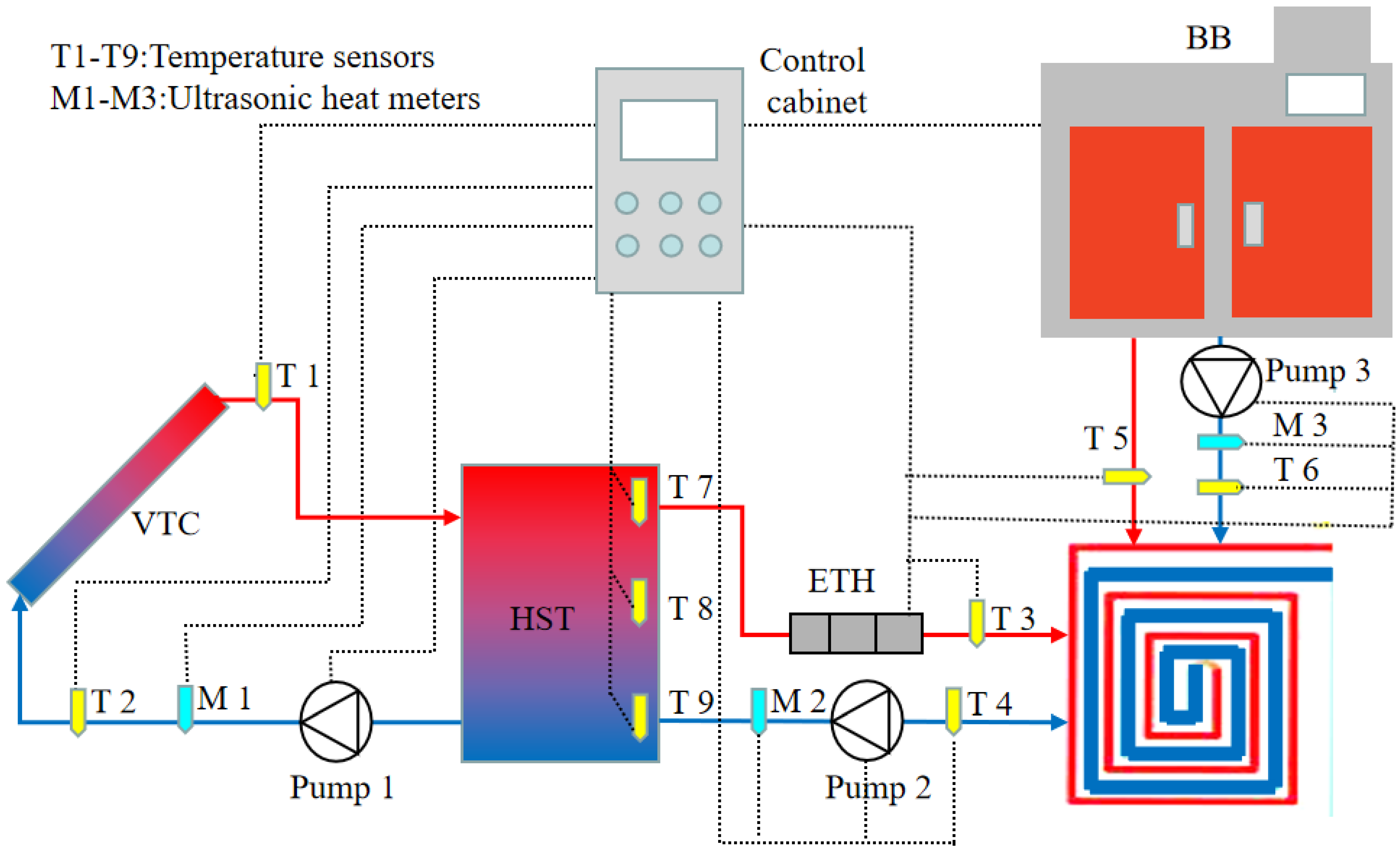


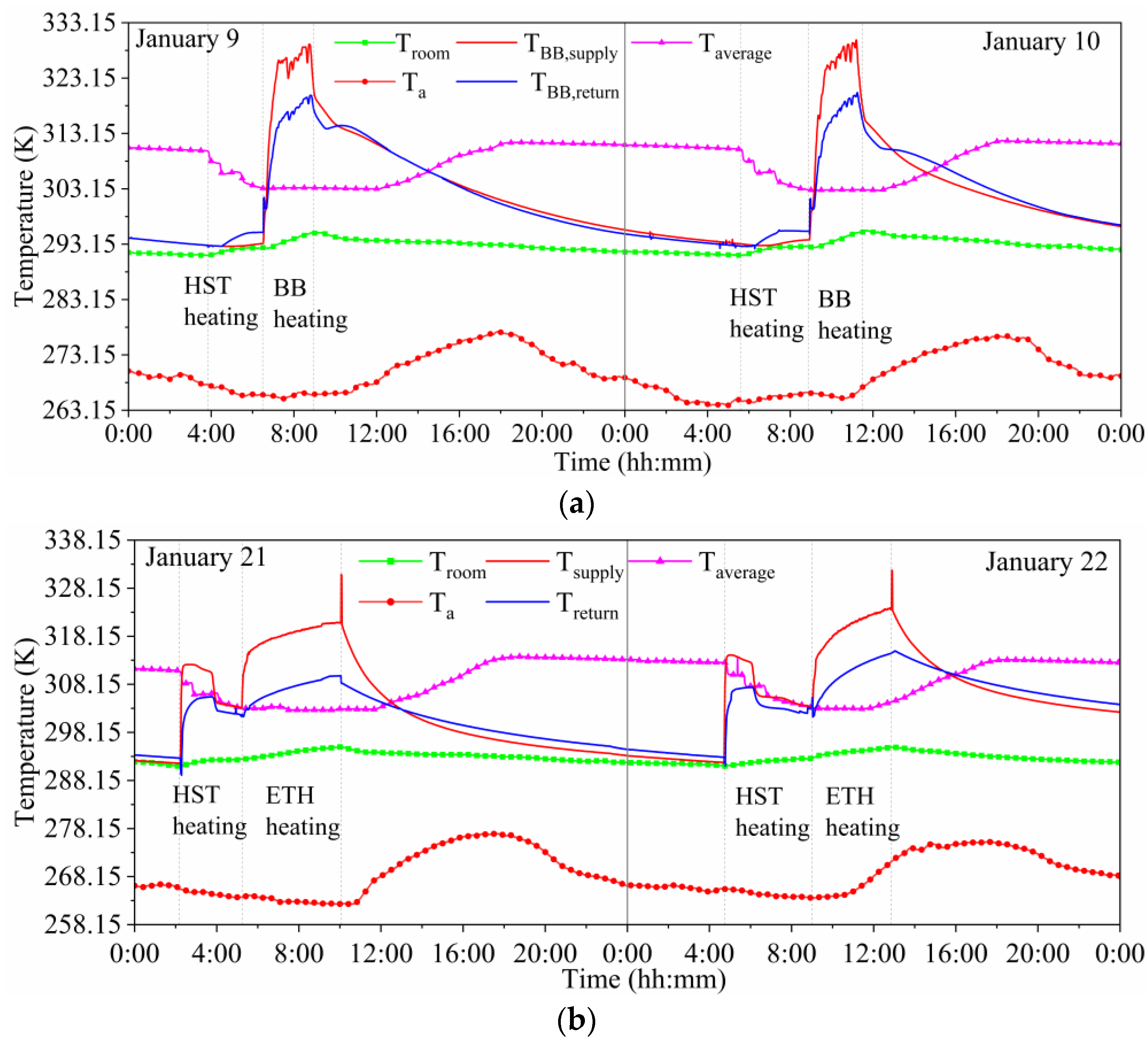
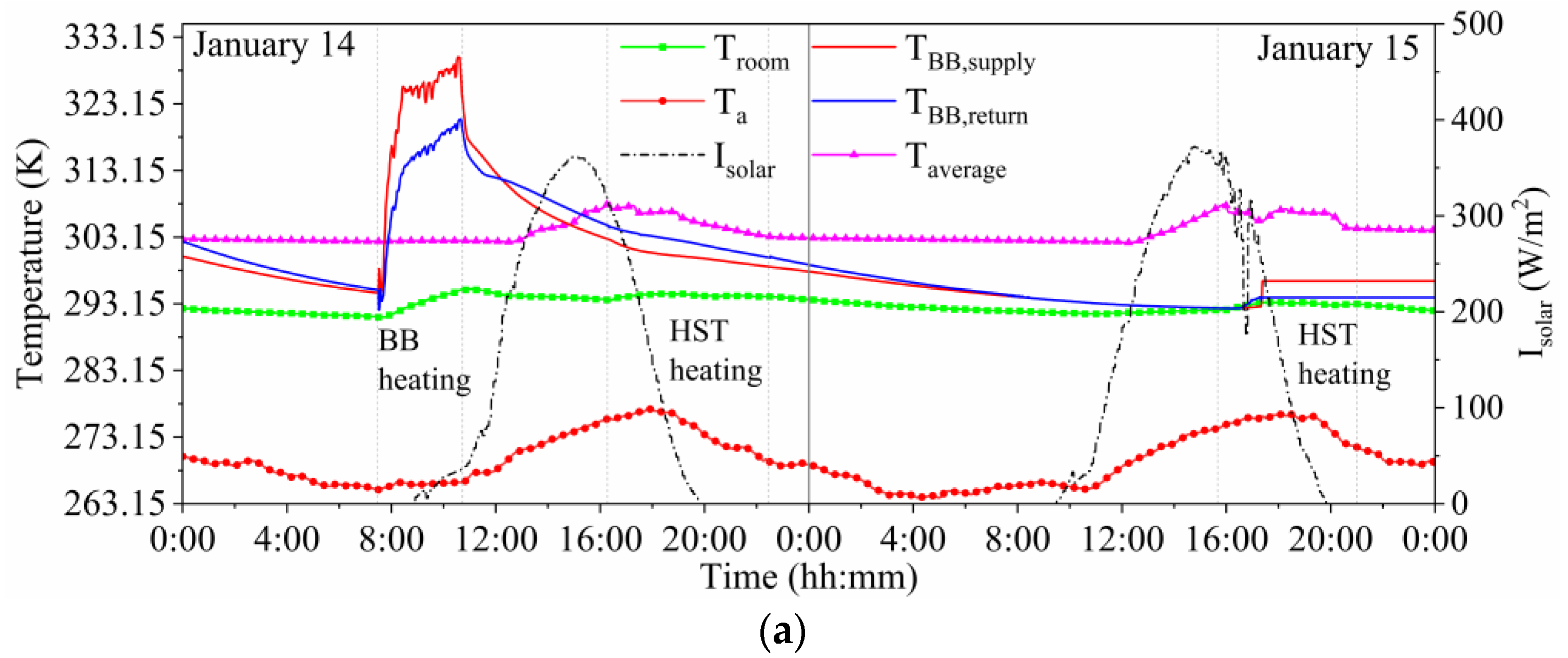
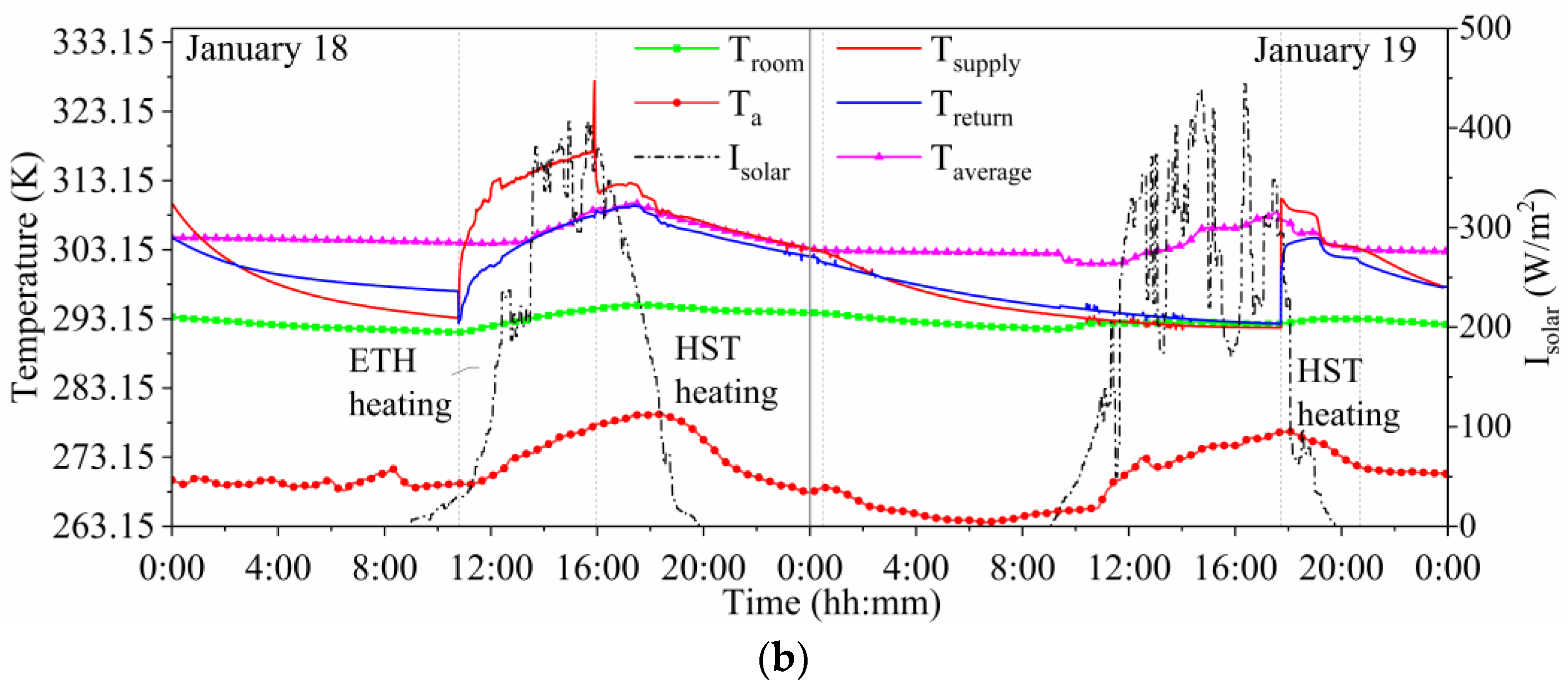
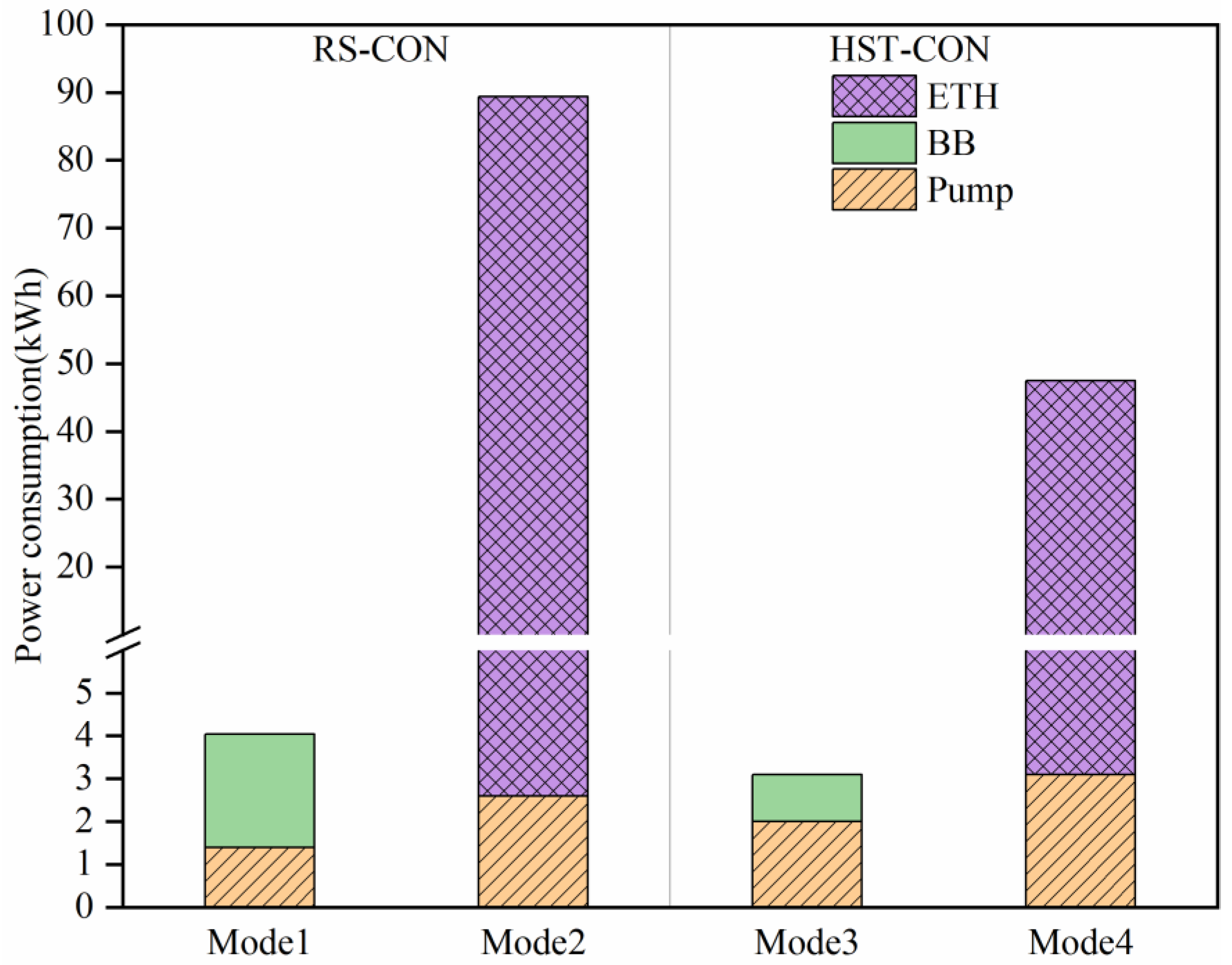



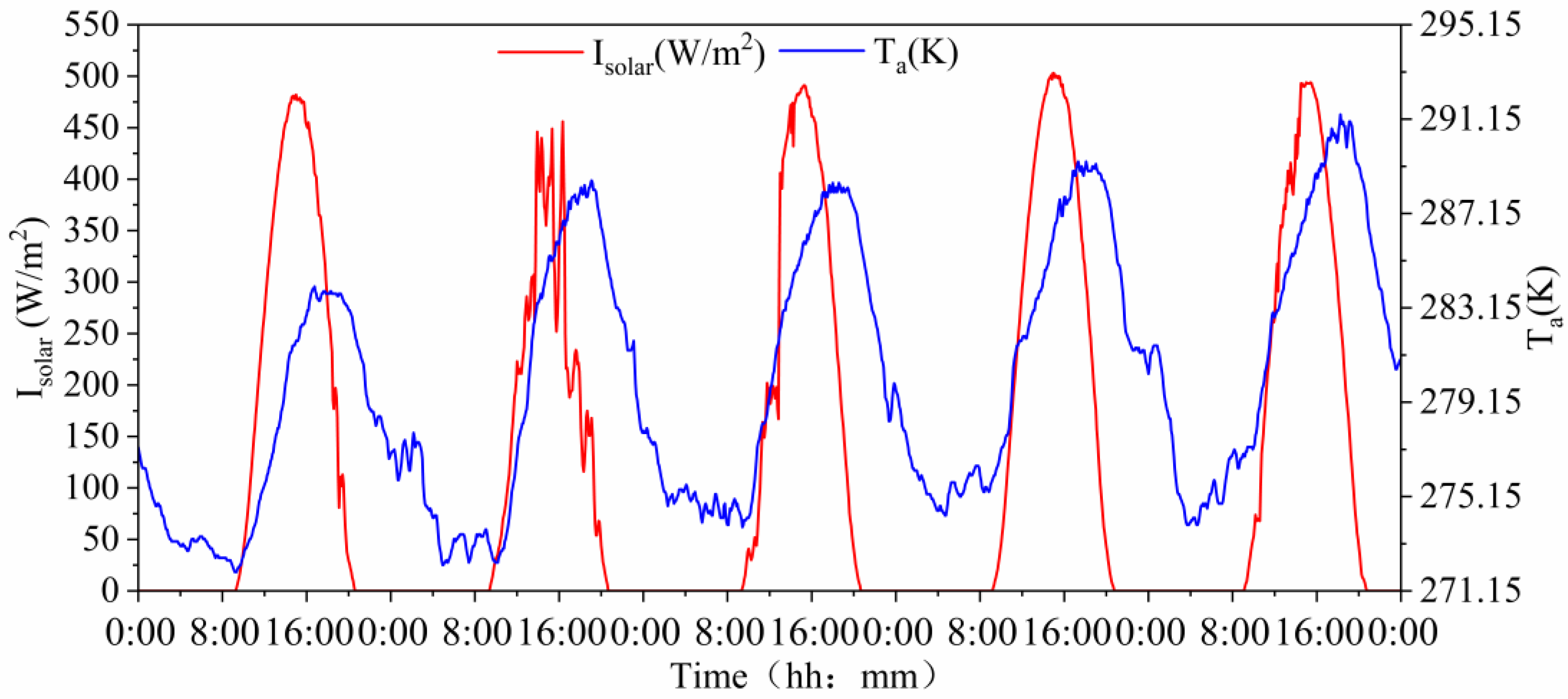


| Control Strategy | Auxiliary Heating (MJ) | Solar Fraction (%) | |
|---|---|---|---|
| RS-CON | Mode 1 | 258.6 | 41.3 |
| Mode 2 | 340.8 | 36.1 | |
| HST-CON | Mode 3 | 177.4 | 52.7 |
| Mode 4 | 199.7 | 46.4 | |
| Control Strategy | Operation Mode | Operation Results |
|---|---|---|
| HST-CON | Mode 3 | The total operation time is 14.35 h, and the total heat supply is 375.37 MJ, and the room temperature is maintained at 291.15–295.15 K. |
| Mode 4 | The total operation time is 16.57 h, and the total heating capacity is 369.1 MJ, and the room temperature is maintained at 291.15–295.15 K. | |
| Time-controlled [32] | Solar + air source heat pump | The outdoor temperature is 255.07 K, the solar heating capacity is 38.41 MJ, the solar fraction is 27.31%, and the room temperature is maintained at 289.15–291.15 K with 11 h of operation. The power consumption of the air source heat pump is 32.2 kWh with 11.5 h operation, and the heat supply is 189.32 MJ, maintaining the room temperature at 289.15–293.15 K. |
| Time and spatial partition heating [21] | Solar + auxiliary heater | The heating duration and temperature are set according to the energy supply of the room. The annual heating capacity is 12,730.23 MJ, and the annual solar fraction is 40.3%. |
| Continuous and whole space heating [21] | Solar + auxiliary heater | The heating system operates all day long, and the room temperature is maintained at 291.15 K. The annual heat supply is 20,120.38 MJ, and the annual solar fraction is 16.3%. |
| Thermal comfort control [33] | Solar + electric | Typical daily power consumption 9.22 kWh, room temperature 287.15–289.15 K. |
| Economic and Environmental Analysis | MECH (HST-CON) | Electricity [31] | Coal-Fired Boiler [38] | Air Source Heat Pump [39] |
|---|---|---|---|---|
| Initial investment cost (RMB/USD) | 33,000(4555.63) | 8485(1171.35) | 5514(761.20) | 32,731.4(4518.55) |
| Annual energy cost (RMB/USD) | 558.2(77.06) | 3185(439.69) | 4292.85(592.63) | 1145.6(158.15) |
| Annual maintenance cost (RMB/USD) | 1384.23(191.09) | 424.25(58.57) | 275.7(38.06) | 1091.05(150.62) |
| Investment payback period (year) | 9.73 | 4.23 | 3 | 11.67 |
| CO2 emissions (kg) | - | 10,737.6 | 9926.4 | 2303.79 |
Publisher’s Note: MDPI stays neutral with regard to jurisdictional claims in published maps and institutional affiliations. |
© 2022 by the authors. Licensee MDPI, Basel, Switzerland. This article is an open access article distributed under the terms and conditions of the Creative Commons Attribution (CC BY) license (https://creativecommons.org/licenses/by/4.0/).
Share and Cite
Ma, X.; Li, J.; Ren, Y.; E, R.; Wang, Q.; Li, J.; Huang, S.; Ma, M. Performance and Economic Analysis of the Multi-Energy Complementary Heating System under Different Control Strategies in Cold Regions. Energies 2022, 15, 8140. https://doi.org/10.3390/en15218140
Ma X, Li J, Ren Y, E R, Wang Q, Li J, Huang S, Ma M. Performance and Economic Analysis of the Multi-Energy Complementary Heating System under Different Control Strategies in Cold Regions. Energies. 2022; 15(21):8140. https://doi.org/10.3390/en15218140
Chicago/Turabian StyleMa, Xuebin, Junfeng Li, Yucheng Ren, Reaihan E, Qiugang Wang, Jie Li, Sihui Huang, and Mingguo Ma. 2022. "Performance and Economic Analysis of the Multi-Energy Complementary Heating System under Different Control Strategies in Cold Regions" Energies 15, no. 21: 8140. https://doi.org/10.3390/en15218140
APA StyleMa, X., Li, J., Ren, Y., E, R., Wang, Q., Li, J., Huang, S., & Ma, M. (2022). Performance and Economic Analysis of the Multi-Energy Complementary Heating System under Different Control Strategies in Cold Regions. Energies, 15(21), 8140. https://doi.org/10.3390/en15218140







